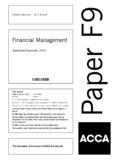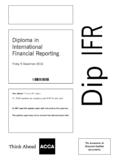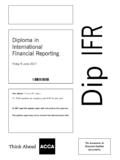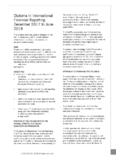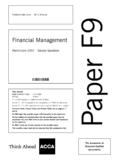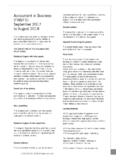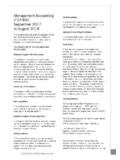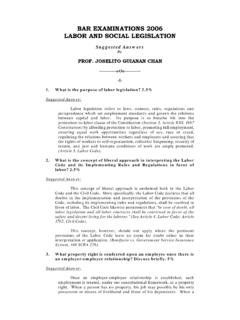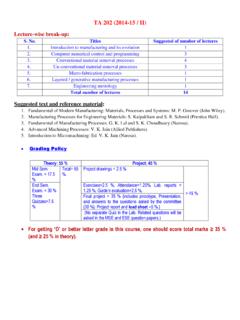Transcription of Answers - ACCA Global
1 Answers139J UKIXP aper P39J UKAAP aper P3 Professional Level Essentials Module, Paper P3 Business AnalysisJune 2009 AnswersIn Essentials module papers it is not always possible to publish a suggested answer which is fully comprehensive. Credit will be givento candidates for points not included in the suggested Answers but which are relevant to the suggested Answers presented below give more detail than would be expected from a candidate under examination conditions. Theanswers are intended to provide guidance on the approach required from candidates, and on the range and depth of knowledge, whichwould be expected from an excellent (a)The current strategic position of greenTechcould be summarised in a brief SWOT analysis.
2 Credit will also be given tocandidates who have used appropriate alternative models or frameworks. Strengths The company has a good financial position, with, by April 2008, a cash surplus of $17 million. The company has explicitly positioned itself as a focused differentiator in a very competitive market place. The company has a stable, successful management team that has been in place since 1990. The company has important core competencies in the production of green technology. It was the development of thesecompetencies that formed the basis of Professor Ag Wan s Despite recent increases, marketing as a whole is under-funded.
3 It currently stands at about 0 3% of turnover. None of the marketing budget is specifically aimed at the sale of fully assembled green computers. This was recognisedby Lewis-Read, who believed that the company should invest in marketing these computers to both home and corporatecustomers. The current process for ordering and configuring computers has a number of efficiency problems. This leads to lowconversion of enquiries into accepted orders. Opportunities The Lewis-Read proposal points out that the government has just agreed a preferential procurement policy for energyefficient computers with high recyclable content.
4 The general public is increasingly conscious of the need to conserve the environment. Green consumers are increasingboth in numbers and visibility. Other industrial sectors are looking for opportunities to provide products that are quiet, recyclable and have lowemissions. Web-based technology now exists that allows customers to construct virtual prototypes of machines and equipment. Threats Although sales are increasing, the company is still relatively small in Global terms and so it is unlikely to be able tocompete with the established Global suppliers of fully assembled computers.
5 There are significant barriers to entry to thismarket. Lack of manufacturing capability is a threat as it makes the company vulnerable to problems in the supply chain. Theacquisition of a manufacturing company to address this is part of Fenix s proposal. (b)The team from the accountants Lewis-Read has suggested a strategy that protects and builds on the company s currentposition. Johnson, Scholes and Whittington identify two broad options within this approach. The first concerns consolidationwhich may include downsizing or withdrawal from certain activities. The second is market penetrationwhere an organisationgains market share, usually by increasing marketing activity.
6 This seems to be what Lewis-Read has in mind. However, their proposal appears to envisage market penetration in only one of the three specific sectors served by greenTech,the provision of fully assembled green computers. This focus is probably based on a perception of high potential demandcoupled with low current marketing investment in this area. Trends suggest that the overall market for this type of computershould be growing rapidly. Domestic customers and companies are increasingly aware of their carbon footprint and wish toreduce consumption both on ethical and economic grounds.
7 The scenario also states that the government is promoting energyefficient computers with high recyclable content in their procurement policy. Consequently, demand should be growing. Onthe other hand, greenTech s marketing spend suggests that not only is the overall budget relatively small, but that none of itappears to be specifically aimed at the green consumer. In contrast, over half of the budget is currently specifically targetedat the electronics industry or home buyers of components. This lack of marketing investment may explain the relatively smallgrowth in sales in the fully assembled green computer s revenue stream.
8 Thus it appears that the company is failing to addressa growing market because its marketing spend is too small, with none of it specifically focused on that sector. It is possible that greenTech s reluctance to market their computers directly to domestic and commercial companies is due totheir perception that they will be seen to be competing with two of their commercial customers. This will require carefulconsideration. However, withdrawal from some activities is a legitimate tactic within a protect and build strategy. Perhapsthe loss of some commercial customers will be more than compensated for by direct computer sales to customers.
9 The second proposal, from the team representing the corporate recovery specialists, Fenix, is to develop products to offer amore comprehensive service to the electronics industry. This is a strategic direction of product development, whereorganisations deliver modified or new products to existing markets. Fenix s suggestion is primarily focused on adding newproducts (expanded product range) and services (special requirements) beyond current capabilities. The scenario suggests149J UKAAP aper P3that 70% of the electronics industry currently use greenTechcomponents somewhere in their products.
10 However, there maybe scope for supplying more products and services to these established customers as well as supplying to those who do notcurrently use greenTech s products. Fenix also makes the point that buying a manufacturing capability will protect the supply chain. greenTechcurrently has nomanufacturing capability of their own and so they are at the mercy of their suppliers. These suppliers might raise prices,supply competitors, fail to meet demand or go out of business. A manufacturing facility could avoid all of these as well asperhaps providing an opportunity to cut supply costs.
